|
Metroxylon sagu - The
Sago Palm
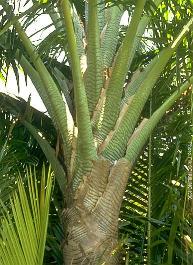 This
species is thought to have originated in Papua New Guinea where, without
doubt, it is one of the most commonly seen palms. It has however spread
from there to many regions in south east Asia because of its tremendous
usefulness. In the Sepik area particularly the palm is the provider of the
staple food. A trunk of a suckering palm is felled just before the
appearance of its terminal inflorescence. Its carbohydrate content is then
at its highest level in order to produce seeds. The marrow of the stem is
laboriously chopped out as finely as possible and its starch then washed
out and separated from the cellulose. This
species is thought to have originated in Papua New Guinea where, without
doubt, it is one of the most commonly seen palms. It has however spread
from there to many regions in south east Asia because of its tremendous
usefulness. In the Sepik area particularly the palm is the provider of the
staple food. A trunk of a suckering palm is felled just before the
appearance of its terminal inflorescence. Its carbohydrate content is then
at its highest level in order to produce seeds. The marrow of the stem is
laboriously chopped out as finely as possible and its starch then washed
out and separated from the cellulose.
This starch is cooked
into a gooey substance and eaten perhaps
with freshly caught fish. The leaves of this palm are commonly used for
thatching which, I am told, will provide at least 5 years of dry shelter.
It has been said that "...where Metroxylon sagu grows, nobody ever
goes hungry". Seram Island, Moluccas, Indonesia
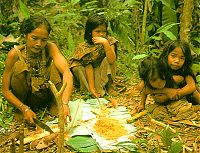 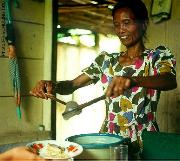
Cultivated
since ancient times, this short, stocky palm is still the most important
source of starch for many tribes on the islands of New Guinea and Borneo.
The center of the palm is hewn out, kneaded, washed, dried and made into
steamed pudding, cakes and crackers.
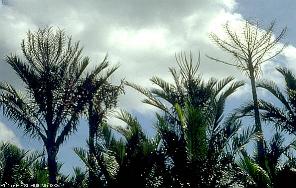 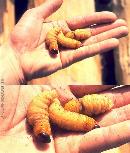
Weevil larvae living inside the palm
are also considered good eating, and sometimes are steamed inside the sago,
making a most interesting dish! Many other parts of the palm are made use
of as well - the trunk, stalks and fronds for building rafters, walls,
mats and baskets.
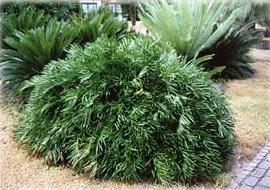 For
local use it is pulverized, but for the market it is usually sieved and
then heated to form granules. The florists’ sago palm is not a true palm
but a cycad of the American genus Zamia. Z. floridana,
called wild sago or coontie, yields Florida arrowroot. For
local use it is pulverized, but for the market it is usually sieved and
then heated to form granules. The florists’ sago palm is not a true palm
but a cycad of the American genus Zamia. Z. floridana,
called wild sago or coontie, yields Florida arrowroot.
Photo credits: Rik
Schuiling - mail to:
[email protected]
|
